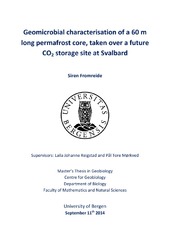Geomicrobial characterisation of a 60 m long permafrost core, taken over a future CO2 storage site at Svalbard
Master thesis
Permanent lenke
http://hdl.handle.net/1956/9353Utgivelsesdato
2014-09-11Metadata
Vis full innførselSamlinger
Sammendrag
In connection with a planned CO2 storage pilot project in the Arctic, a 60 m long permafrost core was drilled in Adventdalen, Svalbard, representing the poorly studied deep permafrost ecosystems. The on-shore drilling was performed through deltaic, marine and glacial sediments, ending at the bedrock at 60 m. Here, seven different depths in the 3-60 m interval of the permafrost core were subjected to culture-independent methods such as 16S rRNA amplicon 454 pyrosequencing and functional and ribosomal gene quantifications to characterise the microbial community composition and abundance. Additionally, geochemical analyses of extracted pore water have been performed, as well as measurements of carbon content, major elements and grain size distributions. The enumeration of bacterial and archaeal 16S rRNA genes showed high copy numbers in top sample at 3 m, a decrease at 4.5 m, and a further decrease from 54 to 60 m. Estimated prokaryotic cell numbers ranged between 3 x 10^5 and 1 x 10^8 cells g^-1 sediment. Detection and quantification of selected functional marker genes indicated that microbial sulphate reduction is more pronounced than methanogenic and methanotrophic processes. A 16S rRNA amplicon pyrosequencing library made with universal prokaryotic primers, revealed a dominance of poorly characterised microbial groups, such as Candidate division TM7, OP9, Chloroflexi Subdivision 11, Deep Sea Archaeal Group (DSAG), Miscellaneous Crenarchaeotic Group and Thermoplasmata. The bacterial and archaeal communities at 3 m were different from the other depths, dominated by Candidate division TM7 and Halobacteria, respectively. Low salt concentrations, high organic carbon content, high cell numbers and different community structure at 3 m suggested influence of surface-related processes such as migration of carbon and meteoric water at this depth. Microbial community composition and geochemistry suggested an anaerobic habitat throughout the core. From 16.5 m to 57 m, the uncharacterised DSAG made up 40-99 % of the archaeal community, increasing their relative abundance with depth. This dominance was confirmed by DSAG specific qPCR. The primers used for amplicon pyrosequencing caused bias in the amplicon library, most likely due to preferential primer-template annealing of the degenerate forward primer. Both the geochemistry and microbial community composition had a marine signature from 16.5 m to 57 m, indicating that the marine depositional environment is the main factor determining microbial community structure, rather than the permafrost environment itself. In relation to potential underground CO2 storage at Svalbard, the results from this study serve as baseline information for future microbial monitoring if CO2 should be stored at the site.
